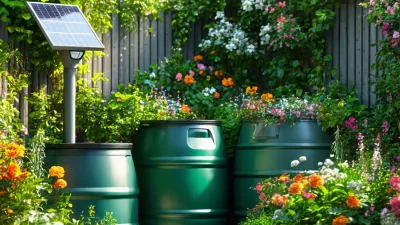The Art of Growing Herbs Indoors: A Guide to Fresh Flavors Year-Round
Imagine stepping into your kitchen and plucking fresh herbs right from your windowsill. It’s not just a fantasy—it’s achievable with indoor herb gardening! Whether you’re a seasoned gardener or a first-time plant parent, growing herbs indoors is a rewarding experience that adds freshness to your meals and beauty to your space.
Why Grow Herbs Indoors?
Before diving into the world of indoor herb gardens, let’s explore why this trend has taken root:
- Freshness on Demand: No need to rush to the store for a sprig of basil or mint. Harvest your herbs whenever inspiration strikes.
- Space Efficiency: Even if you live in an apartment, you can grow herbs in small spaces like windowsills, countertops, or vertical gardens.
- Pest-Free Growing: Indoors, you avoid many outdoor pests that can damage your plants.
- Year-Round Enjoyment: Unlike outdoor gardens, indoor herbs thrive regardless of the season.
Choosing Your Herbs: Popular Picks for Indoor Growing
Not all herbs are created equal when it comes to indoor growing. Some adapt better to low light and controlled environments. Here are some top choices:
- Basil: A staple in Italian cuisine, basil is easy to grow and adds a fragrant touch to your space.
- Mint: Whether for tea or cocktails, mint grows vigorously and can be contained in pots to prevent it from taking over.
- Rosemary: A woody herb that adds a piney flavor to dishes, rosemary is drought-tolerant and low-maintenance.
- Parsley: With its vibrant green leaves, parsley is a versatile herb that complements both savory and sweet dishes.
- Cilantro: Perfect for adding zesty flavors to Mexican, Asian, and Middle Eastern cuisine.
Setting Up Your Indoor Herb Garden
To create a successful indoor herb garden, you’ll need the right tools and setup:
Containers and Soil
Choose the Right Containers: Opt for pots with drainage holes to prevent root rot. You can use anything from sleek ceramic pots to upcycled containers like mason jars or teapots.
Quality Soil: Use a well-draining potting mix specifically designed for herbs or vegetables. Avoid heavy garden soil, as it retains too much moisture indoors.
Lighting: The Key to Success
Natural light is your best friend when growing herbs indoors. Place your plants near south-facing windows for maximum sunlight. If natural light isn’t sufficient, invest in LED grow lights designed for indoor gardening.
Watering Tips
When to Water: Most herbs prefer slightly dry soil between waterings. Stick your finger into the soil—if it feels dry up to an inch deep, it’s time to water.
How Much Water: Water thoroughly until you see water draining from the bottom of the pot. Empty the saucer after watering to prevent standing water, which can lead to root rot.
Fertilizing Your Herbs
Feed your herbs with a balanced, water-soluble fertilizer every 4-6 weeks during the growing season. Be sure to follow the instructions on the package to avoid over-fertilizing, which can burn the plants.
Tips for Maintaining Healthy Herbs
Like any living thing, herbs need love and attention to thrive. Here are some care tips:
- Prune Regularly: Keep your herbs bushy and healthy by pruning regularly. Pinch off the top leaves to encourage branching and more foliage.
- Watch for Pests: While indoor herbs are less prone to pests, keep an eye out for common culprits like spider mites or aphids. Treat them with a mild soap solution or neem oil if detected.
- Rotation is Key: Rotate your plants weekly to ensure all sides receive equal light and prevent them from leaning excessively toward the light source.
Harvesting Your Herbs
The moment you’ve been waiting for—harvest time! Here’s how to get the most out of your herbs:
- When to Harvest: Most herbs can be harvested once they have at least six leaves. For optimal flavor, harvest in the morning after the dew has dried but before the sun is too strong.
- How to Harvest: Snip off individual leaves or sprigs with sharp scissors or剪刀. Avoid taking more than one-third of the plant at a time to ensure it continues to grow.
- Storage Tips: If you can’t use your herbs immediately, they can be stored in the fridge for up to a week in airtight containers or wrapped in damp paper towels. For longer storage, freeze them in ice cube trays with water or olive oil for future use.
Common Mistakes to Avoid
Even experienced gardeners make mistakes. Here are some pitfalls to watch out for:
- Overwatering: Too much water can lead to root rot and other issues. Always check the soil before watering.
- Inconsistent Light: Herbs need consistent light to thrive. If you’re using grow lights, ensure they’re on for at least 12-14 hours a day.
- Not Rotating Plants: Lack of rotation can cause uneven growth and weak stems.
The Joy of Indoor Herb Gardening
Growing herbs indoors is more than just a practical skill—it’s a delightful hobby that connects you with nature, even in the heart of the city. With minimal effort and the right setup, you can enjoy fresh, flavorful herbs year-round. Whether you’re adding a pop of green to your kitchen or impressing friends with homegrown ingredients, indoor herb gardening is a rewarding journey worth embarking on.
So why wait? Grab some pots, soil, and seeds, and start your own indoor herb garden today!





